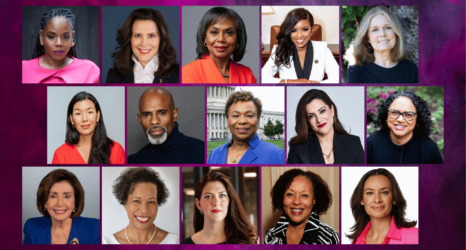Update Monday, Aug. 8, 2022: In Lexington, Mass., a proposal to establish the historic town’s first monument to recognize women’s contributions passed the city’s Select Board unanimously last month. The successful campaign, waged for over two years, includes an innovative, inclusive design from artist Meredith Bergmann.
“After more than two years and thousands of hours of effort, we have succeeded in enlisting an exceptional artist and design, gathering widespread community support, and gaining Select Board approval for a privately funded monument sited in a highly visible location in town center,” said Jessie Steigerwald, president of LexSeeHer, Inc.
Did you know you’re more likely to see a mermaid than a congresswoman memorialized in American monuments in the United States? And you’re much more likely to see a man with a musket than a woman, says the National Monument Audit of 2021.
Up against the centuries-old obsession with white military men in the American monument landscape, women in Lexington, Mass.—ground zero of American military history—are leading the charge to create a monument to women in the town’s history. But they are predictably encountering significant headwinds.

The first shot of the American Revolutionary War was fired on the town commons in the Battle of Lexington on April 19, 1775. The town is now home to the Minute Man National Historic Park commemorating the men who fought in the battle. Women’s contributions at the time are just a footnote on the website.
Lexington is typical. “We may not notice how just a few stories have been disproportionately commemorated in a country created by multitudes,” reads the National Monument Audit, conducted by the Monument Lab—a public art and history studio based in Philadelphia that seeks to “illuminate how symbols are connected to systems of power and public memory.”
“We may not know which voices are missing, which contributions have been elided, or how much the monuments and memorials now standing misrepresent our collective history,” according to the audit.
To address this misrepresentation in Lexington, a dedicated group of volunteers formed the LexSeeHer monument project, in order to commemorate women who have made significant economic, political, intellectual, social and cultural contributions in the “Birthplace of American Liberty”—starting from the early years of the town’s incorporation in 1713 through to the present.
“The monument features over 20 women of different ages, races, professions and other lenses of identity, and spins a more inclusive narrative of Lexington’s history by making women’s contributions to their community and country visible,” said Jessie Steigerwald, president of LexSeeHer.
Designed by Meredith Bergmann, the monument portrays these women in bas relief around an empty central space so visitors can stand among these important women to take their place in the sweep of history. Organizers envision a website where people can share photos of themselves.

Something Is Being Done! encompasses 20 Lexington women. Each “side” is equally important. Women represented on one side are:
- Abigail Harrington (revolutionary mother, declared “Something must be done!” the morning of the Battle of Lexington)
- Woman Burning Tea (revolutionary protester seeking justice through economic/political boycott)
- Eliza Cabot Follen (author, abolitionist), with student
- Ruth Morey (first female Select Board member, first female president Lexington Historical Society)
- Margaret Tulip (Freedom Suit winner)
- Caroline Wellington (suffragist)
- Mary Elizabeth Miles Bibb (first African American graduate of Lexington Normal School, abolitionist, educator, journalist, business woman)
- Peggy Kimball (pilot, founder of LexArt)
- Ruth Buckman (innkeeper at Buckman Tavern during Battle of Lexington)
- Sarah Harkness (mid-century modern architect)
On the other side, the women represented are:
- Enslaved mother with child (representational figures document cruelty of family separation)
- Storyteller and lifelong learner (symbolizing girls and women who are connected across time by learning from history)
- Julia Robbins Barrett (abolitionist, suffragist, designer) with niece Ellen Adelia Stone (lawyer, school committee member, activist)
- Margery Milne Battin (first female town moderator, contributed to current form of local government)
- Anna Harrington (revolutionary protester, hosted 1769 spinning protest)
- Youth activist for liberty, equality, and justice (represents girls who carry forward the Something Must Be Done spirit)
- Cecilia Payne-Gaposchkin (astronomer/astrophysicist)
- Sylvia Ferrell-Jones (social justice activist)
- Phebe Banister Burdoo (revolutionary)
With the support of many in the community, LexSeeHer proposed a site for the women’s monument in the town center, which currently does not have a single monument to recognize women’s contributions to the town’s history among the many monuments to men and their military achievements.
In response, the town’s Tourism Committee and Monuments and Memorials Committee rejected the site, suggesting the women should consider finding a “less offensive site.”
People opposed to the central location proposed, close to Buckman Tavern and the Battle Green, said that it should be “someplace less significant,” “less visible” and “somewhere quiet.”
“Other criticisms we have received include that women had nothing to do with the battle or the Revolution, and that the monument should be smaller and have more feminine curves,” said Valerie Overton, LexSeeHer communications chair. “In reality, women have always played an important role in the pursuit of liberty and freedom.”
These demeaning attitudes are exactly why the monument is needed, says Michelle Tran, LexSeeHer Secretary. “The monument asks questions: What has liberty meant for women? Where is women’s place? What does it mean to be a ‘free’ woman? What did it mean in the 18th century? 19th? 20th? 21st century?”
Criticisms we have received include that women had nothing to do with the battle or the Revolution, and that the monument should be smaller and have more feminine curves. In reality, women have always played an important role in the pursuit of liberty and freedom.
Valerie Overton, LexSeeHer communications chair
The proposed site is across from the town library, adjacent to the commercial center and near the visitors center, on land where one of the women in the monument lived at the time of the Battle of Lexington—a tavern keeper named Ruth Buckman. The site is near the home of Anna Harrington, who hosted 45 women for a spinning protest in 1769, and Margaret Tulip, a woman with Black and Indigenous ancestry who sued for and won her freedom from enslavement in 1768.
The monument recognizes revolutionary women like Phebe Bannister Burdoo, a free Black woman whose son later served in the company of Captain John Parker, and Abigail Harrington, who is shown awakening her son on April 19, 1775 with the call “The Reg’lars are out, and Something Must Be Done!” This slogan was later echoed as a battle cry by Caroline Wellington, a granddaughter of the Revolution and suffragist, also recognized on the monument.
The monument would be sited near the first public Normal School, where Mary Elizabeth Miles Bibb became the first Black woman to graduate in 1843 and went on to work as an abolitionist, journalist and teacher. The monument depicts Bibb alongside astrophysicist Cecilia Payne-Gaposchkin, who discovered the composition of the stars and was the first woman to achieve a tenured position at Harvard that wasn’t reserved for a woman.
Lexington is typical of the American monument landscape featuring white military men—whether it is revolutionary minute men, Confederate soldiers or veterans of later wars—and gives the mistaken impression that white men, and military men, are most worthy of honor and remembrance.

This landscape minimizes the contributions of women and historical figures who made achievements in many other important areas, including peace, public health and civil rights.
“Where inequalities and injustices exist, monuments often perpetuate them,” according to the National Monument Audit report. “Monuments suppress far more than they summon us to remember; they are not mere facts on a pedestal.”
The National Monument Audit calls for us all to ”do our part to change our commemorative landscape and to better capture the multivocality of our country in our public spaces.”
LexSeeHer encourages supporters to write a letter to the Select Board and sign their petition.
Up next:





